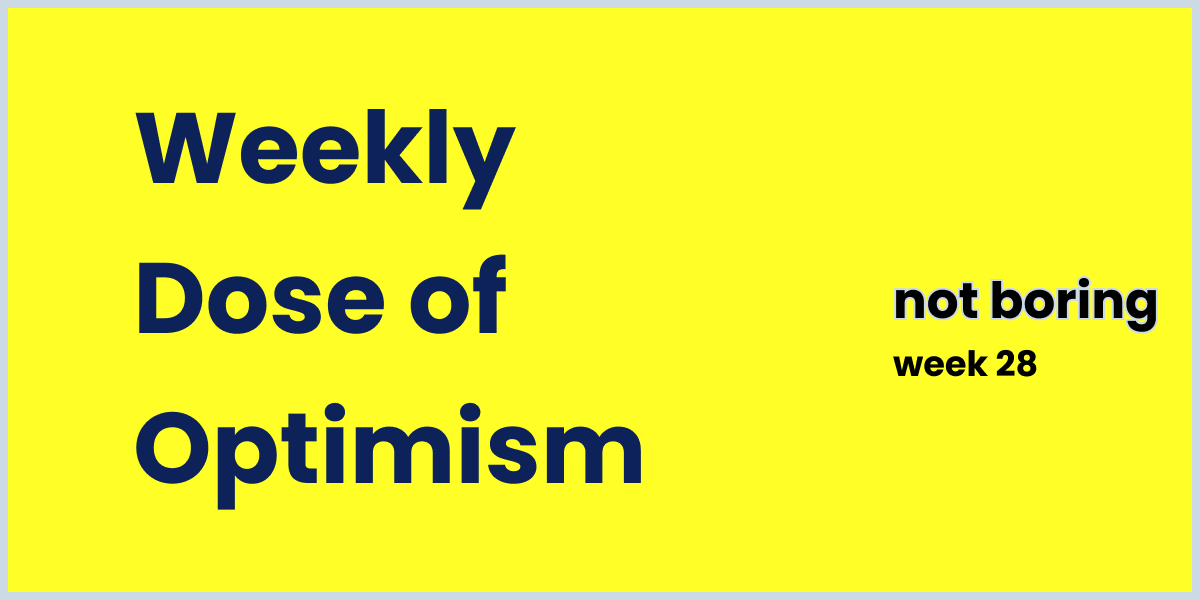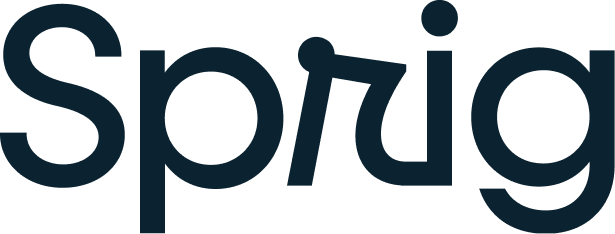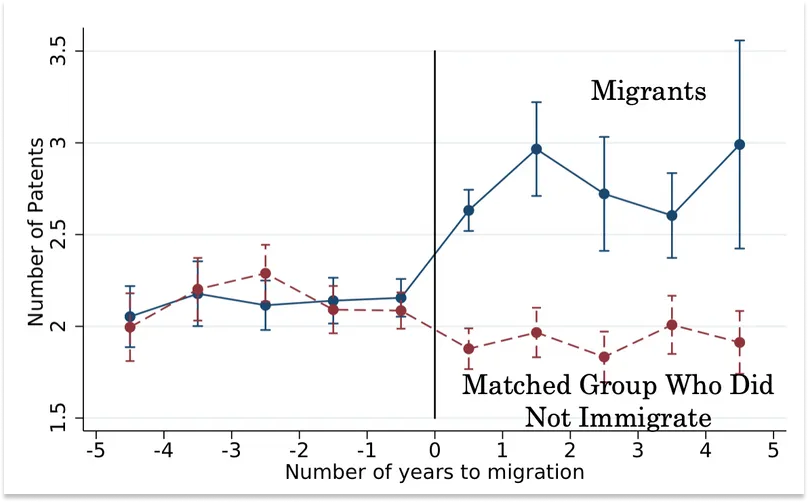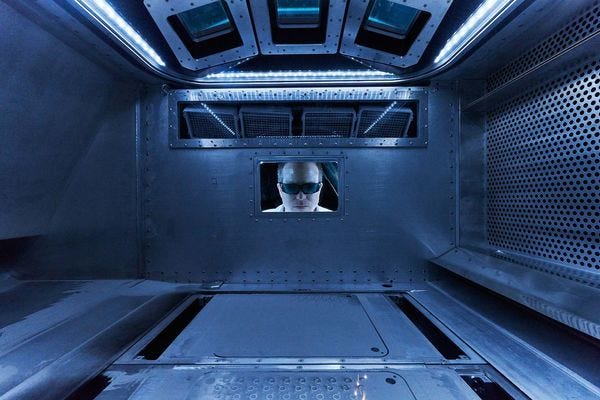

Weekly Dose of Optimism #28
source link: https://www.notboring.co/p/weekly-dose-of-optimism-28
Go to the source link to view the article. You can view the picture content, updated content and better typesetting reading experience. If the link is broken, please click the button below to view the snapshot at that time.

Weekly Dose of Optimism #28
Innovative Immigrants, nEKo, Life Improvements, Elon Bannister, 3D Rocket Parts
Hi friends 👋,
Happy Friday and welcome back to our 28th Weekly Dose of Optimism. Another big week of content over here at Not Boring. It’d be awesome if you could share some of it with a friend or colleague that doesn’t yet know about us.
This week we wrote about Wander — which you can share with anyone that works in real estate, loves Airbnb, or is planning their next getaway.
We also dropped an episode of Not Boring Founders with Sam Levin, the founder of Melonfrost — which you can share with anyone who finds the idea of using evolution and AI to design new organisms as fascinating as we do.
You can of course share this Weekly Dose of Optimism, too!
Let’s get to it.
The Weekly Dose is brought to you by…Sprig
Sprig is the easiest way to collect product feedback, inform product decisions, and increase your speed of innovation. The world’s best product teams including the teams at Notion, Loom, and Robinhood use Sprig’s in-app surveys and concept and usability tests to capture insights from their customers and build better products.
Every week, at the bottom of this newsletter, I use a Sprig survey to get your feedback -- you click a button to tell me whether you loved or hated the newsletter and write a comment, and Sprig categorizes responses with machine learning so that I can get a quick pulse check.
Here’s what I love about Sprig:
The UX is clean and simple, consumer-grade, and they have 75 templates which makes getting started so easy
It’s incredibly fast to source participants and launch a survey or concept test
As a dashboard junkie, I love watching the results and AI-driven insights roll in in real-time, even, and especially, when the feedback is harsh!
We actually almost stopped publishing this newsletter after edition #11 until we ran a Sprig Survey and discovered that 95% of you enjoyed reading it…so you can thank Sprig for the Weekly Dose of Optimism!
Matt Clancy for What’s New Under the Sun
Talent is spread equally over the planet, but opportunity is not. Today I want to look at some papers that try to quantify the costs to science and innovation from barriers to immigration. Specifically, let’s look at a set of papers on what happens to individuals with the potential to innovate when they immigrate versus when they do not.
Clancy’s piece is not an editorial on the benefits of immigration or one of those “Did you know Google, Apple, Amazon, and Facebook were all founded by first or second generation immigrant?” articles. It’s a Substack-style metanalysis on existing papers observing the impact of immigration on scientific research and innovation.
Some of the more interesting findings:
On average, a migrant is about twice as likely to be employed in academia as a mathematician as someone from the same county who got the same math score but did not migrate. (Agrawal et al (2023))
Leaving the USA due to Fulbright requirements is associated with about 65% fewer publications and fewer citations received, and nearly 80% fewer publications in high-impact journals. (Kahn and MacGarvie (2016))
After a few years of adjustment, those who returned (to China) start publishing more than their peers who stayed abroad, with this increase concentrated in last-authored publications (Shi, Liu, and Wang (2023))
The big idea, I think, that Clancy is getting to (and is evidenced in the research he selected) is that it’s not the act of migrating that is good for innovation, but rather migrating to a specific place that’s good for innovation. America has been a hotbed of innovation and scientific research for over a century, not just because of historically high immigration rates, but because it’s established a strong foundation for immigrants to pursue such feats upon landing here. Opportunity + People = Innovation.
2) Spotify founder Daniel Ek officially launches new startup — and this time, he’s taking on healthcare
Mimi Billing for Sifted
Spotify founder and CEO Daniel Ek is launching a new startup which aims to shake up an industry even bigger than music: healthcare. Neko Health will offer advanced full-body scanning to help doctors find and prevent disease. It’s launching after four years of research and development — and hopes to be a gamechanger for Europe’s beleaguered healthcare systems.
Speaking of geography and innovation, Daniel Ek—the Swedish founder of Spotify—has pledged over $1B of his own money to backing deeptech companies from Europe. Yesterday, Ek officially launched one of the moonshot companies he funded: Neko Health. The startup will offer advanced full-body scanning to help doctors find and prevent disease.
Neko is tackling this problem in Europe. In the U.S., companies like Ezra are taking a very similar approach to cancer detection. In both health systems, doctors are often not given the resources needed to detect and prevent diseases from progressing until it’s too late, leading to ballooning costs and relatively low cure-rates.
Technology isn’t a silver bullet here, but detection can help, and making it affordable to more people could lead to better outcomes at lower costs. A founder we recently spoke with surprised us when he said, “There is already a cure for cancer. It’s early detection.” We’re excited to see how this early-detection and preventative care space develops over the coming years.
3) My Ordinary Life: Improvements Since the 1990s
Gwern for Gwern.net
It can be hard to see the gradual improvement of most goods over time, but I think one way to get a handle on them is to look at their downstream effects: all the small ordinary everyday things which nevertheless depend on obscure innovations and improving cost-performance ratios and gradually dropping costs and new material and… etc. All of these gradually drop the cost, drop the price, improve the quality at the same price, remove irritations or limits not explicitly noticed, or so on.
If you could perfectly encapsulate the exact opposite vibe of the one we’re going for here at the Weekly Dose op Optimism, it would be that tweet from QC. We could share all of the graphs and stats that show just how much progress has occurred and how much the quality of life has risen over the past 100 (or even 33) years. But our guess is that that those type of economics-style arguments aren’t going to change the minds of folks like QC. We need real-world examples of how the world has improved. That’s where Gwern comes in. The whole list, shared by @yashkaf in QC’s replies, is worth a read, but sharing some of our favorite (non-obvious, and less serious) ones below:
Universal Cables: USB cables mean that for connecting or recharging, we now only need to figure out ~10 different plugs instead of 1000+ (one for every pairwise device combo)
Movie Theater Seats have become far more comfortable as movie theaters, forced to compete with DVDs/home-theaters & Internet & video games, upgraded. (We’re particularly big fans of Alamo Drafthouse here at Not Boring)
Ethernet: not needing to know the difference between PLIP, SLIP, IRQ, TCP/IP, or PPP to get online.
Wheeled Luggage no longer expensive or rare, but cheap & ubiquitous. s/o my first real job at Away
Better Brussels Sprouts: Brussels sprouts no longer taste quite so bad due to artificial selection against the glucosinolates.
There are other, more serious improvements cited in the essay as well. Some are the result of technological progress, others the result of regulatory change. However you cut it, life has gotten much better of the past 30 years. The world isn’t perfect, but we’re certainly on an upwards slope.
Side note: I think part of QC’s confusion comes from the fact that being a kid rocks.
4) Mercedes Claims to Have Achieved Level 3 Automation, Beating Tesla
Victor Tangermann for Futurism
German automaker Mercedes-Benz claims to have achieved Level 3 autonomy — "conditionally automated" vehicles that can monitor their driving environment and make informed decisions on behalf of the driver, but still require humans to occasionally take over — in the United States, an incremental but noteworthy step towards a future void of steering wheels and foot pedals.
Speaking of progress and technological innovation improving quality of life, Mercedes-Benz claims to have achieved Level 3 autonomy, certified for U.S. market usage. Level 3 Autonomy is one-level above Tesla’s Level 2 Autopilot driver assistance, with the main difference being that drivers don't strictly have to keep their eyes on the road at all times. This level of autonomy could free up, or at least relax, close to 100 billion driving hours in the US each year. We’re still far off from that, but we’re getting incrementally closer both in terms of technological capability and deployment of cars that’ll use this technology.
In other car news:
The cost of >300 mile range EVs has plummeted and the number of models offer by different car makers has tripled…just in the last year. Tesla did most of the leg work here, proving out feasibility and market demand, but now every automaker is introducing compelling EVs.
Both the self-driving story and the EV story are perfect examples of the 4-Minute Mile Effect. A feat is impossible until someone shows that it isn’t.
If you believe in the Tim Urban theory of Elon Musk, this is all part of the plan.
5) A 3D Printer Isn’t Cool. You Know What’s Cool? A 3D-Printing Factory
Ashlee Vance for Bloomberg Businessweek
Instead of trying to build a single machine that can print three-dimensional objects, Freeform is looking to turn entire buildings into automated 3D-printing factories that would use dozens of lasers to create rocket engine chambers or car parts from metal powder. The company, which has never before discussed its approach publicly, says the technique could allow it to make metal parts 25 to 50 times faster than is possible with current methods and at a fraction of the cost.
IT’S TIME TO PRINT, or something.
Ashlee Vance — of Musk biography fame — profiled a former SpaceX engineer’s futuristic 3D printing startup. The startup, Freeform, promises to produce rocket and car parts 25-50x faster and at a fraction of the cost. This has been the general promise of industrial 3D printing for years: cheaper, faster, and often times higher quality. There are, to be certain, companies and startups using 3D printing to that end (notably, SpaceX) but the promise of ubiquitous 3D printing still seems somewhat far off.
Space, however, seems to be one of the more promising industries for 3D printing. There are customers (NASA, SpaceX, Boeing etc) and a growing number of startups competing to disrupt those customers’ historic supply chains, like Freeform, Hadrian, and others.
Whether it starting with 3D printing rocket parts or not, it seems that manufacturing is slowly but surely coming back to America. Atoms are getting sexy again. That’s something we support and can be optimistic about.
Did you enjoy reading this Weekly Dose of Optimism?
(Powered by Sprig)
That’s all for this week. We’ll be back in your inbox on Monday.
Thanks for reading,
Recommend
-
 2
2
Weekly Dose of OptimismWeek 2Jul 8
-
 5
5
Weekly Dose of Optimism #3James Webb, Space Bubbles, Fusion, Guinea Worms, Cancer (+ some Bonuses)10 hr ago
-
 1
1
Weekly Dose of Optimism #4Brain-Computer Interface, Mars Mission, Climate, Hard Work, Kim Stanley Robinson6 hr agoCome for the Optimism, stay for the in-dept...
-
 2
2
Weekly Dose of Optimism #5CHIPS Act, Inflation Reduction Act, Protein Folding, Garbage Removal, Carbon CaptureJul 29
-
 6
6
Weekly Dose of Optimism #6Mini Nuclear Reactors, CHIPs, 1,000,000x Engineers, Alzheimer's and Undead Pigs6 hr ago
-
 4
4
Weekly Dose of Optimism #7Moderna, Reddit Herpes, Carbon Capture, Serena, and Technological Stagnation?2 min ago
-
 4
4
Weekly Dose of Optimism #8Universal Vaccines, Cancer in the Cold, High-Skilled Immigration, The Immigration Flywheel, and the Europeans Come Back to NuclearAug 19
-
 2
2
Weekly Dose of Optimism #9Fermi's Responsibility, Chinese Research, Forever Chemicals, Heated Hydrogen, and the Golden Age of AIAug 26
-
 4
4
Weekly Dose of Optimism #10Artemis I pt. II, EVs & Batteries, Seabed Mining, Intelligent Tools, Passion & Pain, and Dude Where's My Flying Car?15 hr ago
-
 6
6
Weekly Dose of Optimism #11Abolish NEPA, Diablo Days, Interracial Marriages, GUTS, and Abundant Robots19 hr ago
About Joyk
Aggregate valuable and interesting links.
Joyk means Joy of geeK




